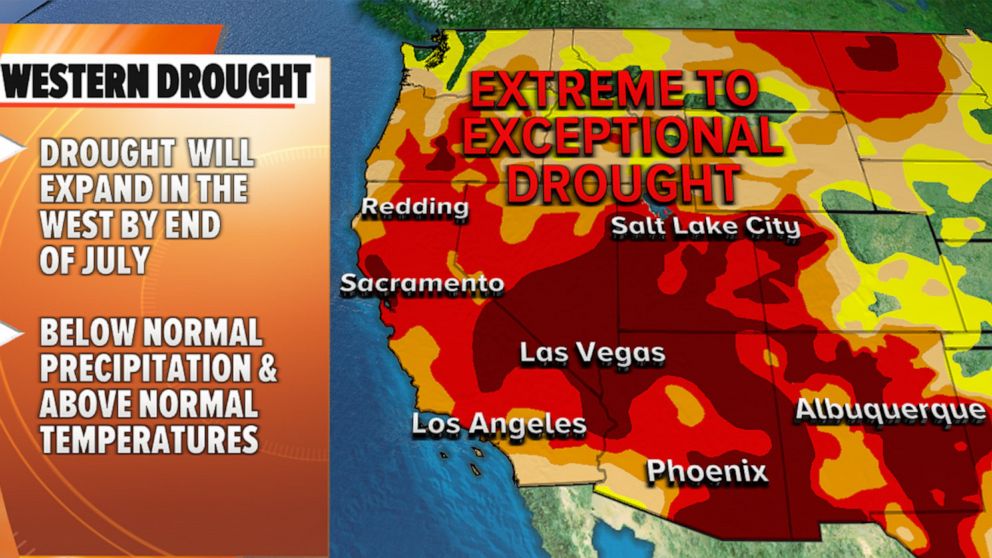Understand and predict the severe drought events in the western United States and their influence on water resources and human health.

The western United States has experienced drought in recent years. In 2022, drought conditions were most severe in the States of California, Texas, Oregon, Nevada, Utah, and New Mexico. As reported in July 2022, more than 32 percent of land in western states was classified as experiencing extreme or exceptional drought.
Drought can adversely reduce the quantity of snowpack and streamflow available, thus greatly influencing the ecosystem, human activities, and human health through environmental influence and social and economic impacts.
This project aims to better understand and predict the severe drought events in the western United States and their impacts on water resources and human health, especially in Northern Utah. We seek collaborations from climate, hydrological, ecosystem, and health science. Our objectives are to 1) develop improved drought metrics based on the historical records and current conditions of the atmosphere, land, and plant available water for an effective drought prediction method; and 2) assess the drought impacts on human health, such as lung health of toxic dust caused by a drought in Great Salt Lake. The ultimate goal of the research is to provide effective drought prediction methods for the western United States and identify significant issues, thus making suggestions for essential decision-making.
Current Status
2025-02-03
The western U.S., including California, Oregon, Nevada, Utah, and New Mexico, has faced severe droughts in recent years. In 2022, over 32% of the region experienced extreme drought, impacting water availability, daily life, and public health. This project focuses on Northern Utah, collaborating with experts in climate, hydrology, and health to: 1) Improve drought prediction using historical and current data, and 2) Examine the hydrological and health impacts of drought. Our goal is to enhance forecasting and provide valuable insights for policymakers.
Research indicates that La Niña and the Madden–Julian Oscillation influenced droughts in the western U.S. from 2020 to 2022, while the North American Monsoon affected summer drought severity. These findings underscore the significance of ENSO, MJO, and monsoon patterns in drought forecasting. The team also evaluated satellite data for drought monitoring and found that groundwater in headwater catchments serves as a strong predictor of stream/runoff efficiency. Groundwater storage variability reflects approximately four years of climate conditions, with Great Salt Lake levels trailing by 1–2 years. This insight aids in predicting water supply and dust exposure risks. Using hospital and meteorological data, researchers are investigating the health effects of drought. Overall, the study establishes a link between regional droughts, groundwater storage, and declining lake levels, which contribute to increased dust exposure and associated health risks.
Publications
Pye, M. and Z. Pu, 2024: Synoptic-scale Circulation of the Western United States Drought of 2021 and 2022. Journal of Applied Meteorology and Climatology. Under revision.
Hou, Z., and Pu, Z. (2023) Assessing CYGNSS Satellite Soil Moisture Data for Drought Monitoring with Multiple Datasets and Indicators. Remote Sensing, 2024, 16(1), 116; https://doi.org/10.3390/rs16010116 https://doi.org/10.3390/rs16010116
Wolf, M., Jamison, L.R., Solomon, D.K., Strong, S., Brooks, P.D. (2023) Multi-year Climatic Controls on Groundwater Storage in Seasonally Snow-Covered Headwater Catchments, Water Resources Research 59 (6), e2022WR033394 https://agupubs.onlinelibrary.wiley.com/doi/abs/10.1029/2022WR033394
Collaborators
ZHAOXIA PU
College of Mines and Earth Sciences
Atmospheric Sciences
Project Owner
PAUL BROOKS
College of Mines and Earth Sciences
Geology & Geophysics
XIAOMING SHENG
College of Nursing
CON DACC DIVISION
Project Info
Funded Project Amount$30K
Keywords
Drought; Hydrology; Plant available water; Human health.
Project Status
Funded 2023
Poster
View poster (pdf)
